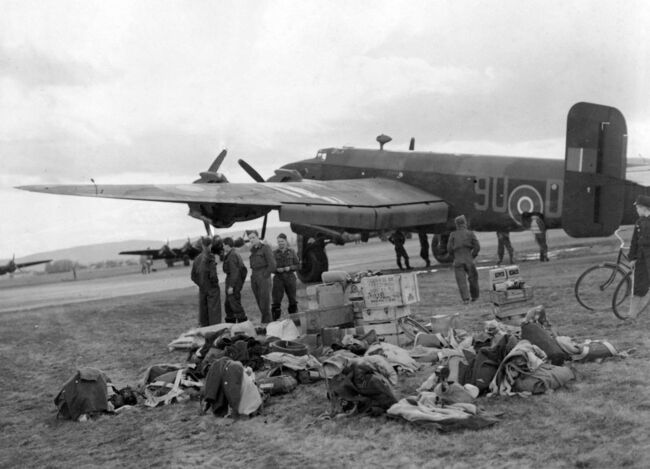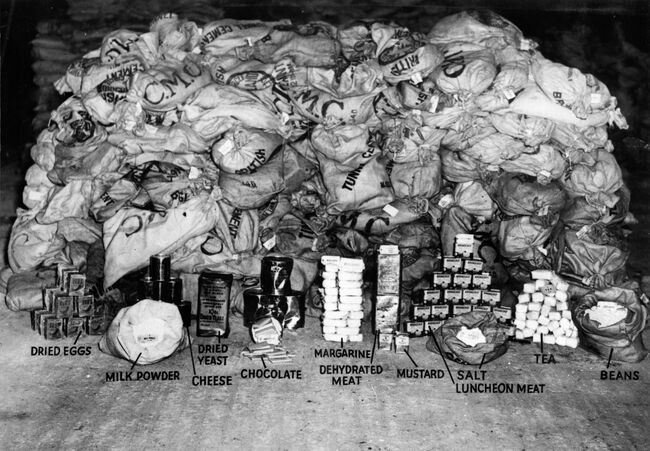
RAF operations during VE Day
Published:
Categories:
VE Day news, World War Two, History and heritage, RAF Family,
To mark 80 years on since VE Day, we take a look at some of the remarkable operations RAF personnel undertook in the lead up and following VE Day.
Operation Exodus
As the Allies advanced, they began to liberate over 350,000 British Prisoners of War (PoWs), as well as American, French, and Soviet PoWs, and concentration camp survivors. The logistical problems of processing, feeding, housing, and providing medical care to these people had been anticipated, and Operation Exodus was prepared to clear as many British personnel from Europe as quickly as possible.
On 3 April, Nos. 38 and 46 Groups from RAF Transport Command began to fly PoWs from Holland and Belgium. Through April, Transport Command repatriated 27,000 PoWs (plus 6,000 wounded from 21st Army Group). On 26 April, RAF Bomber Command was also tasked to Exodus and, by 7 May, 75,000 further PoWs were evacuated in bomber aircraft.
Personnel were landed at several stations across the UK. Over 9,000 landed at RAF Cosford, with over 3,000 arriving later from the Far East. RAF Dunsfold was the busiest, receiving over 41,000 personnel.
A total of around 140,000 PoWs were evacuated by air, in over 6,000 sorties. Only two aircraft were lost, with 40 aircrew and returning PoWs killed. RAF Bomber Command flew 3,586 sorties, and RAF Transport Command flew 2,026, with the US Army Air Forces flying around 500.
Operation Dodge
After the Italian surrender, it became clear that the damaged roads and railways would restrict repatriation efforts, especially as shipping was concentrating on supplying the Far East campaigns. As a result, it was decided the RAF could aid the repatriation troops and staff from the Mediterranean theatre in Operation Dodge.
The codename ‘Dodge’ came out of the nickname ‘D-Day Dodgers’ coined by those involved in the D-Day Landings for those who were fighting in Italy.
Each Lancaster could carry 20 soldiers and their kitbags back on the 6-8 hour flight but as there was no oxygen supply for the passengers, the aircraft had to fly at 2,000ft. Outward trips carried Italian POWs to return home.
Sadly, Lancaster PA278 from No.103 Squadron was lost on 4th October 1945 and was the biggest single loss of female service personnel in World War Two.
Operation Manna
On 29 April 1945 the RAF launched Operation Manna to deliver food and supplies to the starving Dutch people. The mission was launched in the last days of the Second World War after German occupation and the consequences of War in Europe had left the country without food or provisions.

Years of German occupation and war had taken their toll on the Netherlands, leading to thousands of deaths and leaving almost one million people malnourished by the end of the war. People were desperate, eating whatever was to hand including dogs, cats and even tulip bulbs.
Lancaster bombers were adapted to carry life-saving supplies in their bomb bays and the crews trained to fly at levels as low as 300ft.
During a ten-day effort, from 29 April to 8 May, they dropped 6,500 tonnes of food supplies, flying more than 3,000 sorties. Without their efforts, and with the help of the US Air Force, many more people would have starved to death.
Operation Doomsday
Operation Doomsday was a British airborne operation designed to take control of Norway after Germany's surrender, which began the day after VE Day, on 9 May 1945.
At the beginning of May 1945, approximately 380,000 German troops were stationed in Norway. RAF units flew into Norway to accept the surrender of German forces stationed there. No.38 Group, part of RAF Transport Command, transported more than 7,000 troops and over 2,000 tonnes of equipment and supplies between 9-13 May. A further 10,000 troops continued to land after Operation Doomsday in Operation Apostle - launched by the RAF in Oslo after the liberation in 1945.
On 10 May, the main part of the force arrived, but three aircraft were lost. AVM J.R Scarlett-Streatfield CBE was supposed to lead on the transport operation of airborne troops to Gardermoen airfield but was sadly killed in one of the plane crashes.
Operational duties included welcoming back King Haakon VII of Norway, looking after Allied ex-prisoners of war, arresting war criminals and supervising the clearing of minefields. Operation Doomsday was crucial because Norway had been under Nazi occupation since 1940, and German troops might not have surrendered smoothly without a clear Allied presence.
Thank you to Air Historical Branch for providing the information on these operations.